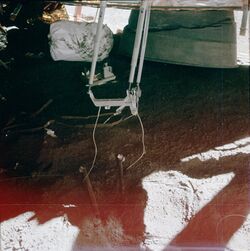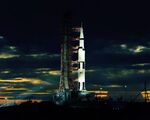Engineering:Descent Propulsion System
| Country of origin | United States |
|---|---|
| Date | 1964–72 |
| Manufacturer | TRW |
| Application | Lunar Descent Stage/Spacecraft propulsion |
| Successor | TR-201 |
| Status | Retired |
| Liquid-fuel engine | |
| Propellant | N2O4 / Aerozine 50 |
| Cycle | Pressure-fed |
| Configuration | |
| Chamber | 1 |
| Performance | |
| Thrust (vac.) | 10,125 lbf (45.04 kN) maximum, throttle between 10% and 60% of full thrust |
| Chamber pressure | 100 psi (690 kPa) (absolute) |
| Isp (vac.) | 311 s (3.05 km/s) |
| Dimensions | |
| Length | 90.5 in (2.30 m) |
| Diameter | 59.0 in (1.50 m) |
| Dry weight | 394 lb (179 kg) |
| Used in | |
| Lunar Module as Descent Engine | |
The Descent Propulsion System (DPS) or Lunar Module Descent Engine (LMDE) is a variable-throttle hypergolic rocket engine developed by Space Technology Laboratories (TRW) for use in the Apollo Lunar Module Descent Stage. It used Aerozine 50 fuel and dinitrogen tetroxide (N2O4) oxidizer. This engine used a pintle injector, a design also used later in the SpaceX Merlin engine.
Requirements
The propulsion system for the descent stage of the Lunar Module was designed to transfer the vehicle, containing two crewmen, from a 60-nautical-mile (110 km) circular lunar parking orbit to an elliptical descent orbit with a pericynthion of 50,000 feet (15,000 m), then provide a powered descent to the lunar surface, with hover time above the lunar surface to select the exact landing site. To accomplish these maneuvers, a propulsion system was developed that used hypergolic propellants and a gimballed pressure-fed ablative cooled engine that was capable of being throttled. A lightweight cryogenic helium pressurization system was also used. The exhaust nozzle extension was designed to crush without damaging the LM if it struck the surface, which happened on Apollo 15.[1]
Development
According to NASA history publication Chariots for Apollo, "The lunar module descent engine probably was the biggest challenge and the most outstanding technical development of Apollo."[2] A requirement for a throttleable engine was new for manned spacecraft. Very little advanced research had been done in variable-thrust rocket engines up to that point. Rocketdyne proposed a pressure-fed engine using the injection of inert helium gas into the propellant flow to achieve thrust reduction at a constant propellant flow rate. While NASA's Manned Spacecraft Center (MSC) judged this approach to be plausible, it represented a considerable advance in the state of the art. (In fact, accidental ingestion of helium pressurant proved to be a problem on AS-201, the first flight of the Apollo Service Module engine in February 1966.) Therefore, MSC directed Grumman to conduct a parallel development program of competing designs.[2]
Grumman held a bidder's conference on March 14, 1963, attended by Aerojet General, Reaction Motors Division of Thiokol, United Technology Center Division of United Aircraft, and Space Technology Laboratories, Inc. (STL). In May, STL was selected as the competitor to Rocketdyne's concept. STL proposed an engine that was gimbaled as well as throttleable, using flow control valves and a variable-area pintle injector, in much the same manner as does a shower head, to regulate pressure, rate of propellant flow, and the pattern of fuel mixture in the combustion chamber.[2]
The first full-throttle firing of Space Technology Laboratories' LEM descent engine was carried out in early 1964. NASA planners expected one of the two drastically different designs would emerge the clear winner, but this did not happen throughout 1964. Apollo Spacecraft Program Office manager Joseph Shea formed a committee of NASA, Grumman and Air Force propulsion experts, chaired by American spacecraft designer Maxime Faget, in November 1964 to recommend a choice, but their results were inconclusive. Grumman chose Rocketdyne on January 5, 1965. Still not satisfied, MSC Director Robert R. Gilruth convened his own five-member board, also chaired by Faget, which reversed Grumman's decision on January 18 and awarded the contract to STL.[2][3]
To keep the DPS as simple, lightweight, and reliable as possible, the propellants were pressure-fed with helium gas instead of using heavy, complicated, and failure-prone turbopumps. Cryogenic supercritical helium was loaded and stored at 3500 psi.[4]:4 The helium was pressure regulated down to 246 psi for the propellant tanks.[4]:4 Pressure from the helium would gradually rise as it warmed and would eventually be vented. The system was also equipped with a rubber diaphragm that would burst when the helium pressure reached a certain level and allow the gas to vent harmlessly into space. Once the helium was gone however, the DPS would no longer be operable. This was not seen as an issue since normally, the helium release would not occur until after the lunar module was on the Moon, by which time the DPS had completed its operational life and would never be fired again.
On Apollo 13 (see below), the helium release did pose a problem since the DPS was the only means of maneuvering the damaged spacecraft and losing the pressure gas meant it could not be used for any midcourse correction burns that would be needed. The helium vent occurred on the sixth day of the mission, however the crew were safely on a trajectory towards Earth by this point and any remaining orbital maneuvers could be performed with the LM's attitude control thrusters.
The design and development of the innovative thrust chamber and pintle design is credited to TRW Aerospace Engineer Dr. Peter Staudhammer.[5] The engine could throttle between 1,050 pounds-force (4.7 kN) and 10,125 pounds-force (45.04 kN) but operation between 65% and 92.5% thrust was avoided to prevent excessive nozzle erosion. It weighed 394 pounds (179 kg), with a length of 90.5 inches (230 cm) and diameter of 59.0 inches (150 cm).[1]
Performance in LM "life boat"
The LMDE achieved a prominent role in the Apollo 13 mission, serving as the primary propulsion engine after the oxygen tank explosion in the Apollo Service Module. After this event, the ground controllers decided that the Service Propulsion System could no longer be operated safely, leaving the DPS engine in Aquarius as the only means of maneuvering Apollo 13.
However, Apollo 13 had left its initial free-return trajectory earlier in the mission, as required for the planned lunar landing at Fra Mauro. Therefore, the first order of business was to re-establish the free return trajectory with a 30.7-second burn of the Lunar Module Descent Engine (LMDE). The descent engine was used again two hours after pericynthion, the closest approach to the Moon ("PC+2 burn"), to speed the return to earth by 10 hours and move the landing spot from the Indian Ocean to the Pacific Ocean. A more aggressive burn could have been performed at PC+2 by first jettisoning the service module, returning the crew in about the same amount of time as a direct abort,[6]p. III-20 but this plan was rejected since it would require leaving the command module's heat shield exposed to the extreme temperatures of space, it would virtually deplete the DPS's propellant supply (leaving nothing for midcourse correction burns), and it would result in Apollo 13 landing in the Atlantic Ocean where the US Navy had no recovery ships placed. The 4-minute 24-second burn was so accurate that only two more small course corrections were subsequently needed before Earth reentry.
Modification for Extended Lunar Module
In order to extend landing payload weight and lunar surface stay times, the last three Apollo Lunar Modules were upgraded by adding a 10-inch (25 cm) extension to the engine bell to increase thrust. The nozzle exhaust bell, like the original, was designed to crush if it hit the surface. It never had on the first three landings, but did buckle on the first Extended landing, Apollo 15.
TR-201 in Delta second stage
After the Apollo program, the DPS was further developed into the TRW TR-201 engine. This engine was used in the second stage, referred to as Delta-P, of the Delta launch vehicle (Delta 1000, Delta 2000, Delta 3000 series) for 77 successful launches between 1972–1988.[7]
References
- ↑ 1.0 1.1 "Mechanical Design of the Lunar Module Descent Engine". http://heroicrelics.org/info/lm/mech-design-lmde.html.
- ↑ 2.0 2.1 2.2 2.3 "Chapter 6. Lunar Module - Engines, Large and Small". Chariots for Apollo: A History of Manned Lunar Spacecraft. https://history.nasa.gov/SP-4205/ch6-5.html.
- ↑ "LM Descent Propulsion Development Diary". Encyclopedia Astronautica. http://www.astronautix.com/craft/lmdlsion.htm.
- ↑ 4.0 4.1 APOLLO EXPERIENCE REPORT - DESCENT PROPULSION SYSTEM - NASA Technical Note: March 1973
- ↑ Dressler, Gordan A.; Bauer, J. Martin (2000). TRW Pintle Engine Heritage and Performance Characteristics. AIAA. AIAA-2000-3871. http://smartdata.usbid.com/datasheets/usbid/2001/2001-q1/pintleenginepaperaiaafinal.pdf. Retrieved 4 June 2012.
- ↑ "Apollo 13 Mission Operations Report". April 28, 1970. https://history.nasa.gov/alsj/a13/A13_MissionOpReport.pdf.
- ↑ Ed Kyle (April 9, 2010). "Extended Long Tank Delta". Space Launch Report. http://www.spacelaunchreport.com/thorh10.html. Retrieved May 11, 2014.
External links
- NASA Technical Note: APOLLO EXPERIENCE REPORT - DESCENT PROPULSION SYSTEM. March 1973 31 pages, lots of detail on both designs, and the testing.
- Apollo Lunar Module Propulsion Systems Overview, NASA
- Rocket Propulsion - The Apollo Mission, Don Harvey, Mr. Harvey worked at STL designing the LMDE



